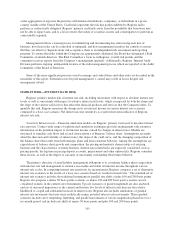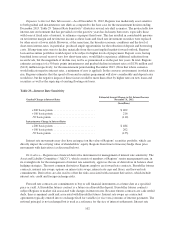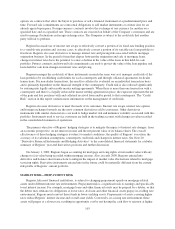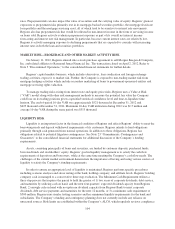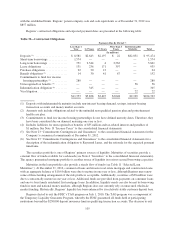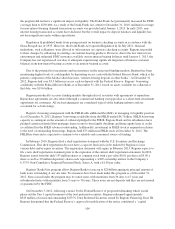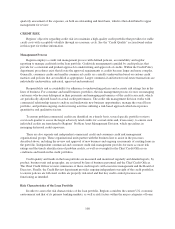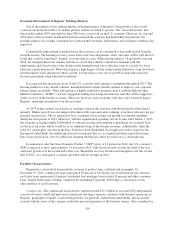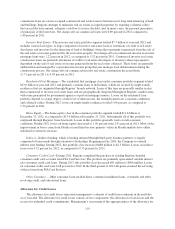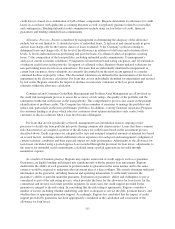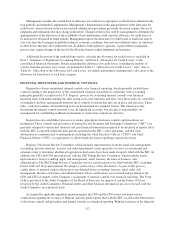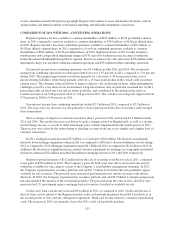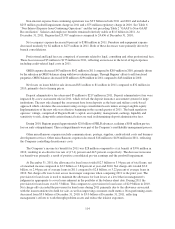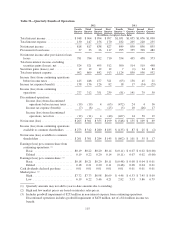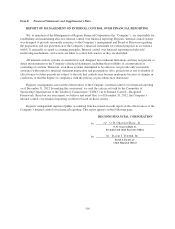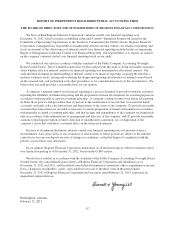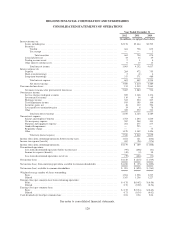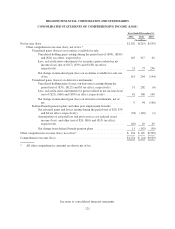Regions Bank 2012 Annual Report Download - page 127
Download and view the complete annual report
Please find page 127 of the 2012 Regions Bank annual report below. You can navigate through the pages in the report by either clicking on the pages listed below, or by using the keyword search tool below to find specific information within the annual report.credit losses is based on a combination of both of these components. Regions determines its allowance for credit
losses in accordance with applicable accounting literature as well as regulatory guidance related to receivables
and contingencies. Binding unfunded credit commitments include items such as letters of credit, financial
guarantees and binding unfunded loan commitments.
Allowance Process—Factors considered by management in determining the adequacy of the allowance
include, but are not limited to: 1) detailed reviews of individual loans; 2) historical and current trends in gross
and net loan charge-offs for the various classes of loans evaluated; 3) the Company’s policies relating to
delinquent loans and charge-offs; 4) the level of the allowance in relation to total loans and to historical loss
levels; 5) levels and trends in non-performing and past due loans; 6) collateral values of properties securing
loans; 7) the composition of the loan portfolio, including unfunded credit commitments; 8) management’s
analysis of current economic conditions; 9) migration of loans between risk rating categories; and 10) estimation
of inherent credit losses in the portfolio. In support of collateral values, Regions obtains updated valuations for
non-performing loans on at least an annual basis. For loans that are individually identified for impairment in
certain loan categories, those valuations are currently discounted from the most recent appraisal to consider
continued declines in property values. The discounted valuations are utilized in the measurement of the level of
impairment in the allowance calculation. For loans that are not individually identified for impairment and secured
by real estate, Regions considers the impact of declines in real estate valuations in the loss given default
estimates within the allowance calculation.
Commercial and Consumer Credit Risk Management and Problem Asset Management are all involved in
the credit risk management process to assess the accuracy of risk ratings, the quality of the portfolio and the
estimation of inherent credit losses in the loan portfolio. This comprehensive process also assists in the prompt
identification of problem credits. The Company has taken a number of measures to manage the portfolios and
reduce risk, particularly in the more problematic portfolios. In addition, a strong Customer Assistance Program
for consumer lending is in place which educates customers about options and initiates early contact with
customers to discuss solutions when a loan first becomes delinquent.
For loans that are not specifically reviewed, management uses information from its ongoing review
processes to stratify the loan portfolio into pools sharing common risk characteristics. Loans that share common
risk characteristics are assigned a portion of the allowance for credit losses based on the assessment process
described above. Credit exposures are categorized by type and assigned estimated amounts of inherent loss based
on several factors, including current and historical loss experience for each pool and management’s judgment of
current economic conditions and their expected impact on credit performance. Adjustments to the allowance for
loan losses calculated using a pooled approach are recorded through the provision for loan losses; adjustments to
the reserve for unfunded credit commitments calculated using a pooled approach are recorded through
noninterest expense.
As a matter of business practice, Regions may require some form of credit support, such as a guarantee.
Guarantees are legally binding and entered into simultaneously with the primary loan agreements. Regions
underwrites the ability of each guarantor to perform under its guarantee in the same manner and to the same
extent as would be required to underwrite the repayment plan of a direct obligor. This entails obtaining sufficient
information on the guarantor, including financial and operating information, to sufficiently measure the
guarantor’s ability to perform under the guarantee. Evaluation of guarantors’ ability and willingness to pay is
considered as part of the risk rating process, which provides the basis for the allowance for loan losses for the
commercial and investor real estate portfolio segments. In some cases, the credit support provided by the
guarantor is integral to the risk rating. In concluding that the risk rating is appropriate, Regions considers a
number of factors including whether underlying cash flow is adequate to service the debt, payment history, and
whether there is appropriate guarantor support. Accordingly, Regions has concluded that the impact of credit
support provided by guarantors has been appropriately considered in the calculation and assessment of the
allowance for loan losses.
111


